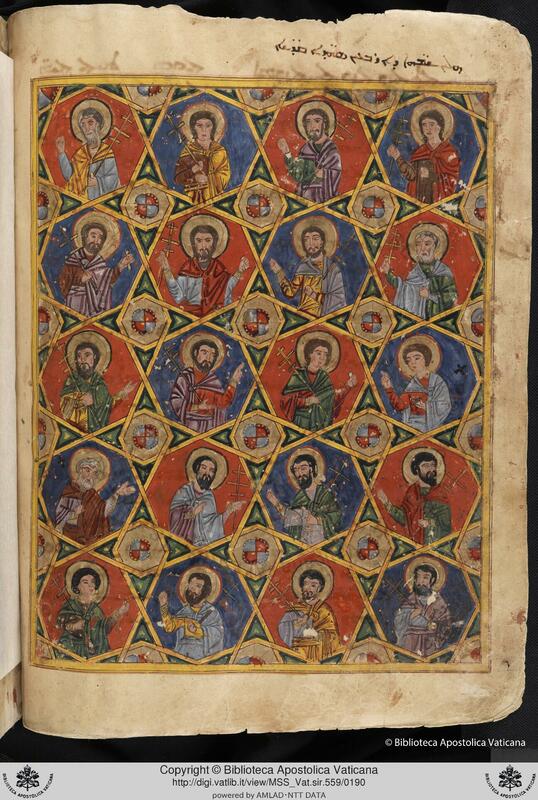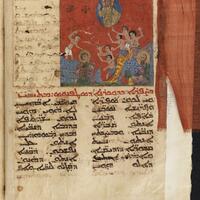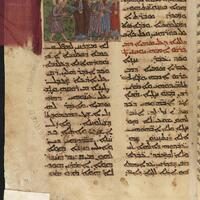Syriac lectionary from Iraq
Date:
1220 or 1260
Location or Findspot (Modern-Day Country):
Iraq
Medium:
Gold,
Lapis lazuli,
Paper,
Tempera
Dimensions:
43.5 × 33.5 cm
Description:
This paper codex comprising 250 folios is a luxurious Gospel lectionary of the West Syrian (Jacobite) liturgical tradition. A colophon states that it was commissioned by Rabban 'Abdallah ibn Khusho ibn Shim'un for the monastery of Mar (= Saint) Mattai, Mar Zakkai, and Mar Abraham near Mosul (eastern Iraq). The name of the scribe is recorded (Mubarak, a monk at Mar Mattai), as is the date, either 1220 or 1260. The unnamed artists (who may not have been monks) used six pigments, including lapis lazuli, in addition to gold leaf.
Many illuminated Gospels and lectionaries were produced in the region of Syria and Iraq between the eleventh and thirteenth centuries. The Vatican manuscript's fifty-plus images correspond with major feasts and ceremonies of the Christian year. Many still have pieces of cloth stitched alongside to veil the pictures, a common medieval practice. Fol. 1r depicts the evangelists Matthew and Mark writing (or contemplating) their Gospels, inspired by the hand of God. Fol. 16r, the Nativity scene, follows Byzantine models. The Syriac text in red slightly overlaps the picture's lower margin, so the image was executed before the text. Fol. 20v shows the stoning of St. Stephen, the first Christian martyr (Acts 7). On fol. 88r, Christ heals a haloed blind man who carries the bag of a pilgrim; once again the text overlaps the image. Jesus's entry into Jerusalem is shown on fol. 105r: he rides a donkey from the Mount of Olives toward the city's Golden Gate, which in the Middle Ages was a two-story, domed building, as shown here. The decorative panel above the scene is identical to those found in local Islamicate manuscripts.
An exceptional two-page spread (cols. 93v–94r) depicts the Forty Martyrs of Sebaste, commemorated on 9 March; in the early fourth century, they froze to death on an icy lake rather than renounce their Christian faith. Their martyrdom is not shown; rather, they are displayed as portrait busts in a colorful pattern of octagons that resembles the (nonfigural) double carpet pages of local Qur'ans and other books. Martyrs were especially revered in the Syrian Orthodox Church, and perhaps their veneration responded to increasing pressure on western Asian Christians to convert to Islam.
Many illuminated Gospels and lectionaries were produced in the region of Syria and Iraq between the eleventh and thirteenth centuries. The Vatican manuscript's fifty-plus images correspond with major feasts and ceremonies of the Christian year. Many still have pieces of cloth stitched alongside to veil the pictures, a common medieval practice. Fol. 1r depicts the evangelists Matthew and Mark writing (or contemplating) their Gospels, inspired by the hand of God. Fol. 16r, the Nativity scene, follows Byzantine models. The Syriac text in red slightly overlaps the picture's lower margin, so the image was executed before the text. Fol. 20v shows the stoning of St. Stephen, the first Christian martyr (Acts 7). On fol. 88r, Christ heals a haloed blind man who carries the bag of a pilgrim; once again the text overlaps the image. Jesus's entry into Jerusalem is shown on fol. 105r: he rides a donkey from the Mount of Olives toward the city's Golden Gate, which in the Middle Ages was a two-story, domed building, as shown here. The decorative panel above the scene is identical to those found in local Islamicate manuscripts.
An exceptional two-page spread (cols. 93v–94r) depicts the Forty Martyrs of Sebaste, commemorated on 9 March; in the early fourth century, they froze to death on an icy lake rather than renounce their Christian faith. Their martyrdom is not shown; rather, they are displayed as portrait busts in a colorful pattern of octagons that resembles the (nonfigural) double carpet pages of local Qur'ans and other books. Martyrs were especially revered in the Syrian Orthodox Church, and perhaps their veneration responded to increasing pressure on western Asian Christians to convert to Islam.
Relevant Textbook Chapter(s):
8,
9
Repository and Online Resources:
• The lectionary (Vat. sir. 559) has been digitized by the Vatican Library.
Image Credits:
Biblioteca Apostolica Vatican






